







 |
 |
 |
||
 |
 |
 |
 |
 |
 |
Voynich MS - Quire 9 |  |
||
|---|---|---|---|---|
DescriptionQuire 9 contains one bifolio composing folios 67 and 68, both folding out to contain several panels with text and illustations. A small strip of parchment has been sewn in in addition. The gathering mark, unusually, is on f67r1. The reason for this appears to be that this bifolio has been bound incorrectly into the manuscript, after the quire number was written (further detailed below).
Schematic folio layout:
| ||||
 |
 |
Folio 67 |  |
 |
|
Foldout folio. The folio number is on f67r1. | ||||
 |
 |
f67r1 |  |
|
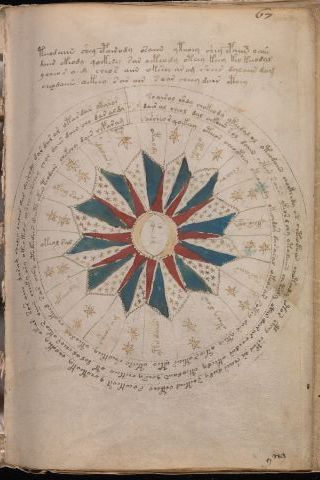
>>Link to 2014 scan (Beinecke digital library), showing pages 67r1 and 67r2 from left to right. >>Link to 2004 scan (Jason Davies Voyager), showing pages 67r1 and 67r2 from left to right. General descriptionThis is an astronomical page. For general information about astronomical pages see here. The folio nr. (67) is near the upper right corner, just to the left of an erased older folio nr., which cnnot be read convincingly but could be either 62 or 67. The gathering mark (9n9) is in the lower right corner. Illustration(s)In the centre of the large circular illustration is a moon with a face and crescents on either side. Outside that is a 12-pointed star with red, blue and white segment with small stars drawn in the white segments. Outside that, but inside a ring of circular text, are radiating patterns, two for each of the 12 star points, one with writing and one with one or two larger stars. Text
This page has 19 text items (loci), as follows:
At the top, above the drawing, are four lines of text in a single paragraph. As part of the illustration there are three circular bands of text on the outside of the drawing. Inside that are twelve words or word pairs along radii of the circles.
Currier language: -
Browse interlinear transliteration of f67r1 Tentative identifications
Other information
| ||||
 |
f67r2 |  |
||
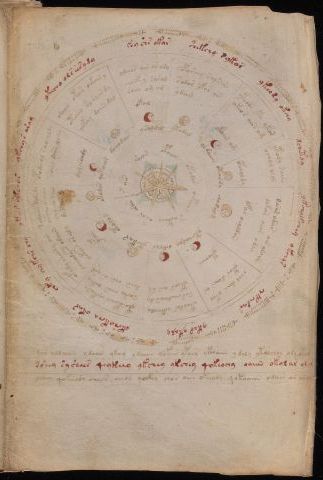
>>Link to 2014 scan (Beinecke digital library), showing pages 67r1 and 67r2 from left to right. >>Link to 2004 scan (Jason Davies Voyager), showing pages 67r1 and 67r2 from left to right. General descriptionThis is an astronomical page. For general information about astronomical pages see here. Illustration(s)This is a large circular illustration with a small circle in the centre, and twelve segments outside that. In the centre is an 8-pointed star with clouds, with a short sentence written around it. Each of the segments has, from outside to inside, a word or words written in red ink, a short paragraph of text and a small moon face either in red or faint yellow. Text
This page has 74 text items (loci), as follows:
There are three lines of writing in a single paragraph at the bottom of the page. The second line of this is written in red ink, and the paragraph has been ruled. The writing in the outer band is a short group of words for each segment in red ink, then a short paragraph in each of the twelve segments. In seven of the twelve, one word is standing a bit in isolation. There are additional words below the moon faces in each segment, and a shot piece of circular text inside that. Both the ruling and the use of red ink are only found on this page, and are unique for the MS.
Currier language: -
Browse interlinear transliteration of f67r2 Tentative identificationsIt is very likely that the twelve segments represent either the 12 signs of the zodiac or the twelve months of the year. Other informationSimilar illustrations are quite common in other manuscripts. The seven more or less separate words are very suggestive, and could represent the seven planets. | ||||
 |
f67v2 |  |
||
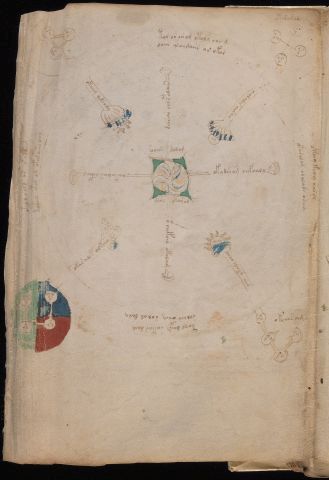
>>Link to 2014 scan (Beinecke digital library), showing pages 67v2 and 67v1 from left to right. >>Link to 2004 scan (Jason Davies Voyager), showing pages 67v2 and 67v1 from left to right. General descriptionThis is a so-called cosmological page. For general information about cosmological pages see here. Illustration(s)There is one large circle centred on the page and 4 smaller circles in the four (NE, SE, SW and NW) corners. In the centre of the large circle is a green square with a circular hole and a star or sun with spiralling rays. From the square, 4 lines radiate out in the N, S, E and W directions. Four lines come in towards the square from the perimeter of the large circle in the NE, NW, SE and SW direction. These appear to be continued with similar lines in the 4 small circles. Each of the eight lines are terminated with a branching broccoli-like structure. The small circles in the corners contain between three and four human faces, joined by lines. Only the one in the SW corner has been painted in red, blue and green. Text
This page has 22 text items (loci), as follows:
Text has been written along each of the eight radiating lines. There are also sentences of Voynich text above, below, to the left and the right of the large circle.
Currier language: -
Browse interlinear transliteration of f67v2 Tentative identifications
Other information
| ||||
 |
f67v1 |  |
 |
|
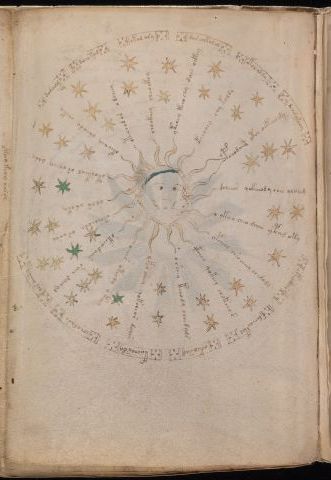
>>Link to 2014 scan (Beinecke digital library), showing pages 67v2 and 67v1 from left to right. >>Link to 2004 scan (Jason Davies Voyager), showing pages 67v2 and 67v1 from left to right. General descriptionThis is an astronomical page. For general information about astronomical pages see here. Illustration(s)This is a large circular design with a sun face in the middle with wavy rays. The circle is subdivided into 17 segments by lines of writing, and each segment has 1, 2 or 3 stars. In total three stars are painted blue. All others are faint yellow. There are patterns along the outer perimeter. Text
This page has 29 text items (loci), as follows:
There are 12 words or word pairs written along the perimeter of the outer circle. There are 17 lines of text radiating out from the centre of the circle.
Currier language: -
Browse interlinear transliteration of f67v1 Tentative identifications
Other information
| ||||
 |
 |
Folio 68 |  |
 |
|
Three-way foldout folio. The folio nr. is on f68v2. | ||||
 |
 |
f68r1 |  |
|
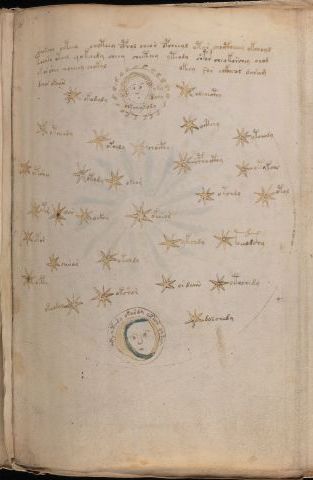
>>Link to 2014 scan (Beinecke digital library), showing pages 68r1, 68r2 and 68r3 from left to right. >>Link to 2004 scan (Jason Davies Voyager), showing pages 68r1, 68r2, 68r3 from left to right. General descriptionThis is an astronomical page. For general information about astronomical pages see here. Illustration(s)Near the top is a sun face with small rays, and near the bottom a moon face. In between are 29 scattered stars, each with a label. Text
This page has 37 text items (loci), as follows:
There are four lines of text at the top of the page, in a single paragraph. The fourth line consists of just two words. The 'floating paragraphs' consists of three words near the sun, and there is a piece of circular text around the moon.
Currier language: -
Browse interlinear transliteration of f68r1 Tentative identifications
Other information
| ||||
 |
f68r2 |  |
||
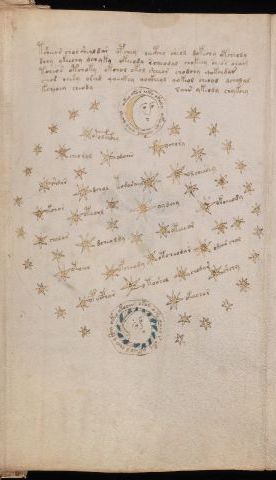
>>Link to 2014 scan (Beinecke digital library), showing pages 68r1, 68r2 and 68r3 from left to right. >>Link to 2004 scan (Jason Davies Voyager), showing pages 68r1, 68r2, 68r3 from left to right. General descriptionThis is an astronomical page. For general information about astronomical pages see here. Illustration(s)Near the top is a moon face and near the bottom a sun face with small rays painted blue. There is a large circle of unlabeled stars connecting sun and moon. The area inside this is also filled up with stars, of which most (but not all) have a label. Text
This page has 31 text items (loci), as follows:
There are five lines of text at the top of the page, in a single paragraph. The fifth line is interrupted by the moon drawing. There are 24 labels, one near each of the stars. There are two pieces of circular text, one around the moon and one around the sun.
Currier language: -
Browse interlinear transliteration of f68r2 Tentative identifications
Other informationThe text around the sun appears to have some non-Voynich characters, perhaps cleartext. As always it is almost impossible to read. | ||||
 |
f68r3 |  |
||
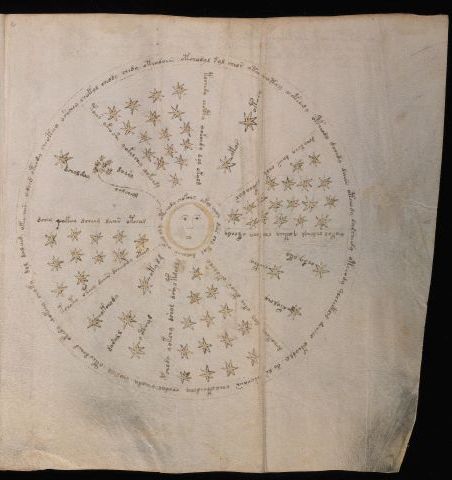
>>Link to 2014 scan (Beinecke digital library), showing pages 68r1, 68r2 and 68r3 from left to right. >>Link to 2004 scan (Jason Davies Voyager), showing pages 68r1, 68r2, 68r3 from left to right. General description
This is an astronomical page. For general information about astronomical pages
see here.
Illustration(s)A large circular drawing, surrounded by a piece of circular text. There is a moon with a face in the centre. There are 8 radiating spokes dividing the circle into 8 segments. These are alternatively filled with many small stars, or a few somewhat larger stars with labels. In the upper left segment there is an additinal group of 7 small stars with a label, and a curved line connecting it to the moon. Text
This page has 22 text items (loci), as follows:
There is a long circular text on the outside and a short circular text around the moon face. There are 8 lines of text along radii of the circle (the above-mentioned spokes). There are 12 labels in total. Ten are star labels, one belongs to the small group of seven stars and one to the connecting line (the 'astronomical' label).
Currier language: -
Browse interlinear transliteration of f68r3 Tentative identificationsIt is generally assumed that the group of seven stars represents the Pleiades. Alternatively, it could also represent the seven planets. The line connecting the group of stars to the moon has been interpreted as some celestial event involving the Pleiades and the moon. The label near the seven stars is a popular crib. The word () has been interpreted as meaning Taurus. Other informationIt is often believed that the proposed translation of 'Taurus' for the label was first proposed by Stephen Bax, but he himself has clearly stated that this was already suggested many years ago. In fact, his proposed reading is 'taurn'. | ||||
 |
f68v3 |  |
||
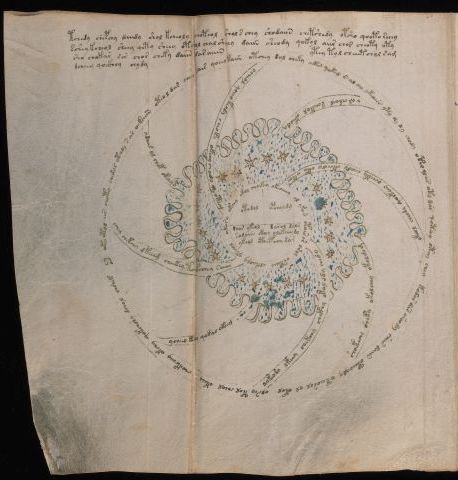
>>Link to 2014 scan (Beinecke digital library), showing pages 68v3, 68v2 and 68v1 from left to right. >>Link to 2004 scan (Jason Davies Voyager), showing pages 68v3, 68v2, 68v1 from left to right. General description
This is a so-called cosmological page. For general information about cosmological pages
see here.
Illustration(s)This large circular drawing has a ring of text on the outside and a T-O map in the centre. There are eight bands contining lines of writing, spiralling in from the outside circle to the T-O map. Approximately halfway between the T-O map and the large circle is a boundary drawn as a wavy line, also known as 'nebuly' or 'Wolkenband'. The area between the T-O map and this boundary is painted blue and has a number of stars painted yellow. Text
This page has 19 text items (loci), as follows:
There are four lines of text in a single paragraph, at the top of the page. There is a large circular text on the outside of the drawing and a small circular text around the T-O map. The two small qudrants of the T-O map are filled with a single word each (label), and the larger one with three lines ('floating' paragraph text). There are 8 lines of writing along the spirals, which have been classified as radial writing.
Currier language: -
Browse interlinear transliteration of f68v3 Tentative identificationsThis is the illustation that Newbold considered to represent the Andromeda nebula (i.e. galaxy), which is certainly not possible. Ellie Velinska showed that there are several images in other manuscripts with a similar T-O map, and a starry sky delimited by a nebuly line. These refer to Aristotle's De Caelo, and the topic of this page in the MS could therefore be related to the rotation (or not) of the spheres. Other information
| ||||
 |
f68v2 |  |
||
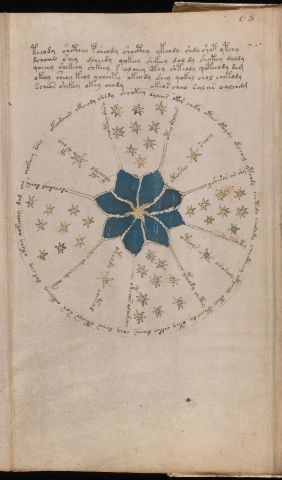
>>Link to 2014 scan (Beinecke digital library), showing pages 68v3, 68v2 and 68v1 from left to right. >>Link to 2004 scan (Jason Davies Voyager), showing pages 68v3, 68v2, 68v1 from left to right. General description
This is an astronomical page. For general information about astronomical pages
see here.
Illustration(s)A circular diagram, a bit smaller than most other similar diagrams. In the centre is an 8-pointed star painted blue, with a yellow heart, that looks more like a flower than a star. There are 8 segments, which are alternatingly filled with many small stars, or with a single star with some words before and after it. Text
This page has 18 text items (loci), as follows:
There are 5 lines of text in a single paragraph, at the top of the page, above the drawing. There is a large circular text along the outside of the drawing. There are 12 lines of radial text, 8 along the segment boundaries, and four including one star each.
Currier language: -
Browse interlinear transliteration of f68v2 Tentative identifications
Other informationThis is one of the few cosmological diagrams in the Voynich MS that also exist in other manuscripts. | ||||
 |
f68v1 |  |
 |
|
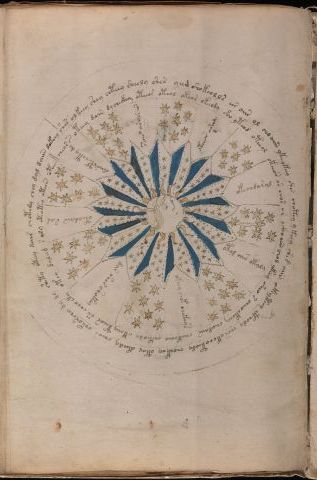
>>Link to 2014 scan (Beinecke digital library), showing pages 68v3, 68v2 and 68v1 from left to right. >>Link to 2004 scan (Jason Davies Voyager), showing pages 68v3, 68v2, 68v1 from left to right. General descriptionThis is a so-called cosmological page. For general information about cosmological pages see here. Illustration(s)A large circular drawing, with a sun face in the centre. Outside this is a large star-shaped composition with alternating blue segments, and white segments filled with small stars. Between this star shape and the outside of the circle are 16 segments, alternatingly filled with stars, or with a few words of text. Outside that are two circles of writing, where the start points have been marked by lines. Outside this text is a thin outline of an even larger circle. Text
This page has 10 text items (loci), as follows:
There are two long circular texts, both along the outside of the drawing. The 8 pieces of radial text are in the segments that have no stars.
Currier language: -
Browse interlinear transliteration of f68v1 Tentative identifications
Other information
| ||||
 |
 |
 |
||
 |
 |
 |
 |
 |